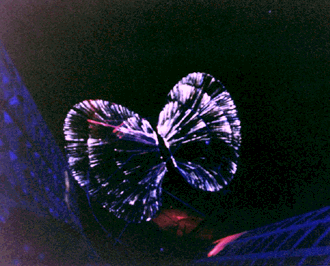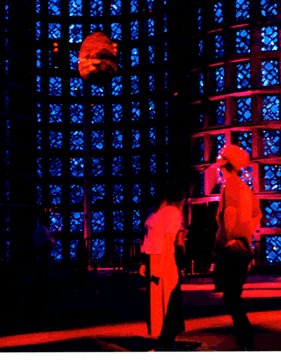
Satori
Artists: Dirk Rutten and Jeroen Kascha

|
Dirk Rutten and Jeroen Kascha, Satori, interactive light sculpture installation, 1998. (Photos: Cynthia Pannucci) When visitors entered the darkened space of the Great Hall, they heard the "scrunching" sounds of insects coming from three different directions. After adjusting to the darkness, visitors naturally began to walk towards the sounds produced by three, small, glowing objects hung just above the floor. These objects appeared to be floating in space; curiosity drew visitors in for a closer examination. When a visitor drew close enough to begin to see some distinguishing features, the little glowing and buzzing objects appeared to be cocoons. Then suddenly the sound and the light disappeared, revealing overhead an immense, 16-ft butterfly that flickered brilliantly for a few seconds. This burst of light was produced by thousands of capillary-like light strands. But as quickly as the angel-like, fiber-optic butterfly emerged, it disappeared. As long as the visitors remained physically close to the cocoons, nothing happened. An infrared motion sensor in the cocoons detected when visitors got closer than 6 feet to the Satori. When visitors moved far enough away, the sounds and light of the cocoons would reactivate and the cycle would begin again. Satori is the Japanese Buddhist term for sudden enlightenment. In Satori, the search for and experience of knowledge was manifested in light and in the study and observation of nature. High-tech culture and the basics of human experience of nature met in the Hall of Science.

Jeroen Kascha and Dirk Rutten, |
| LightForms |
| gallery entrance |
| past exhibitions |
| Leonardo On-Line |